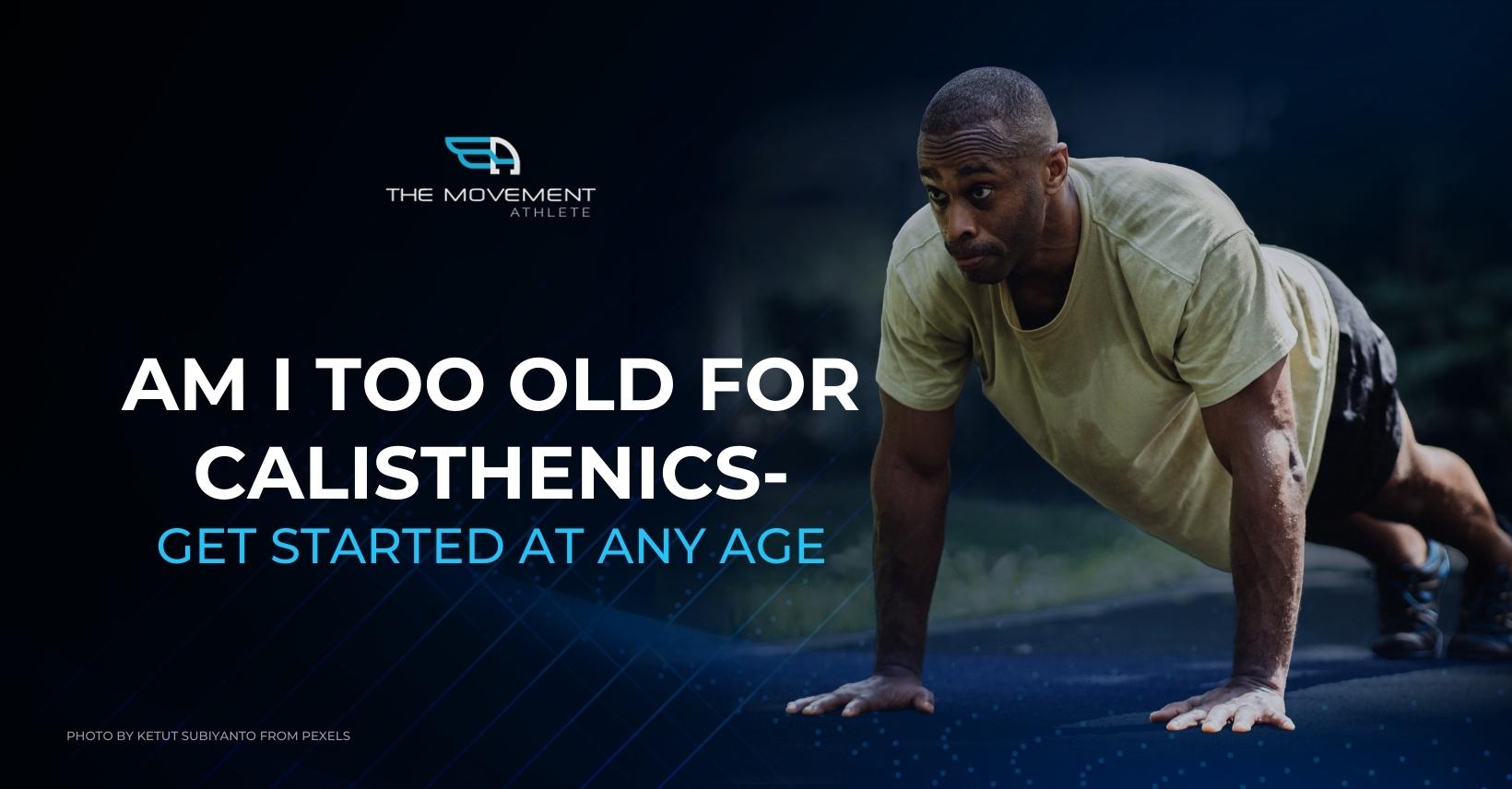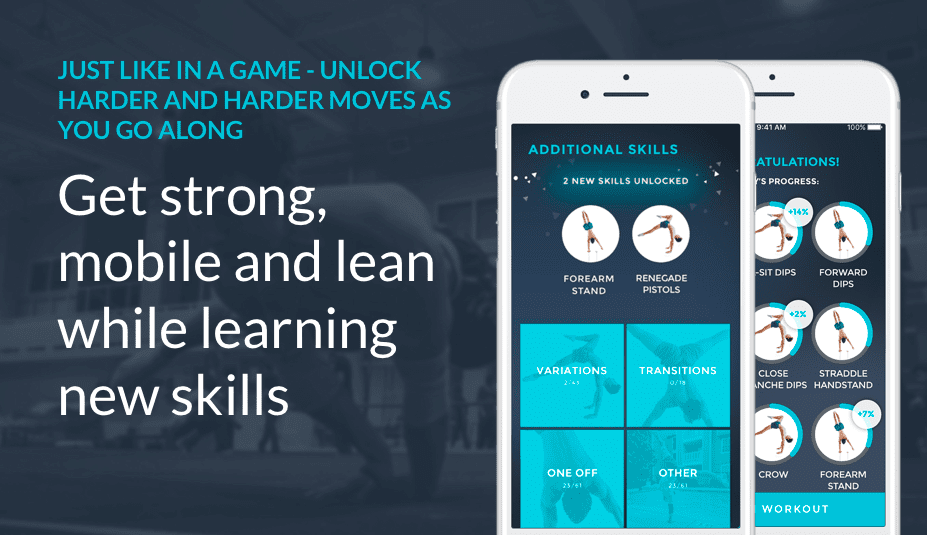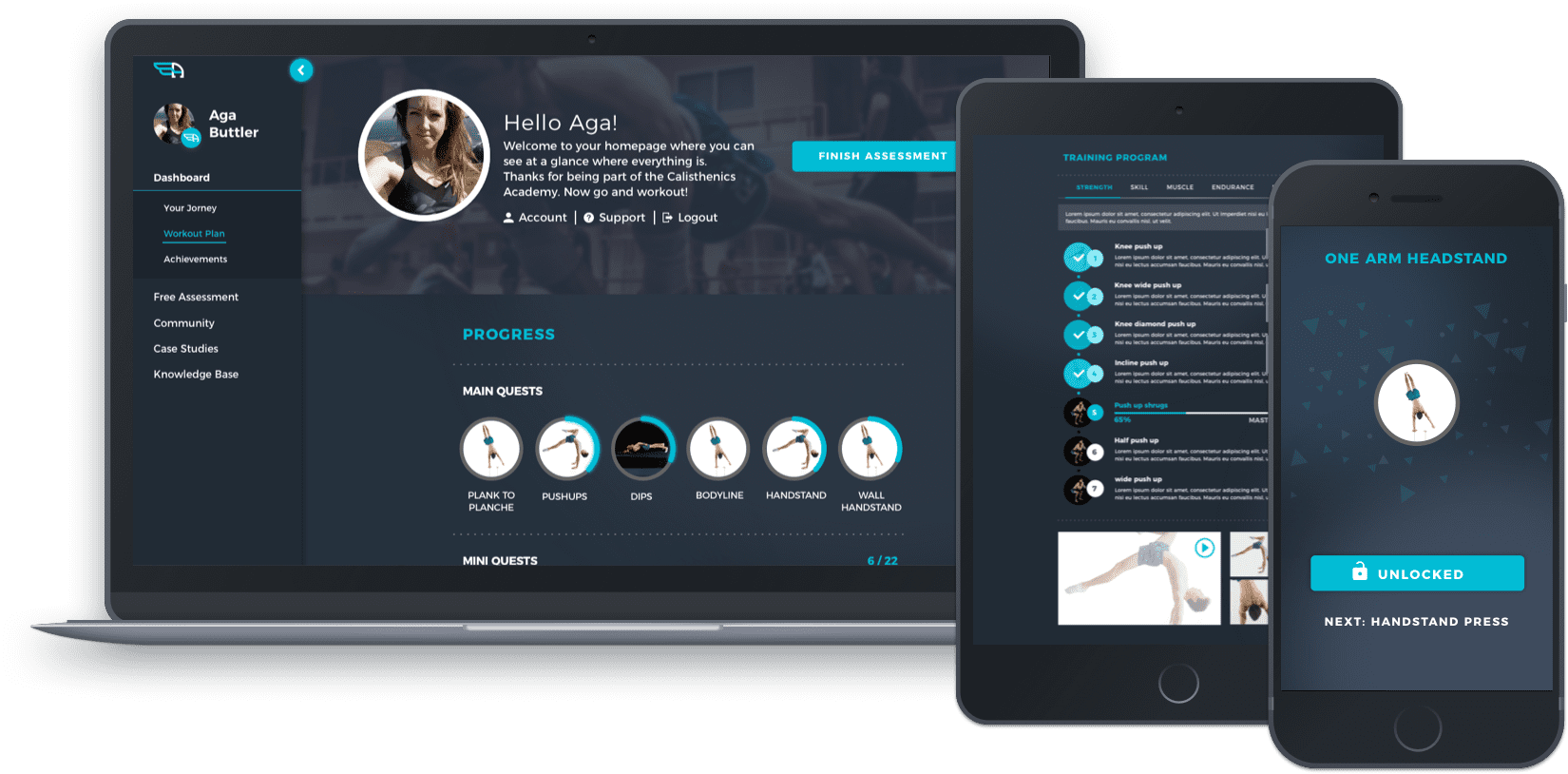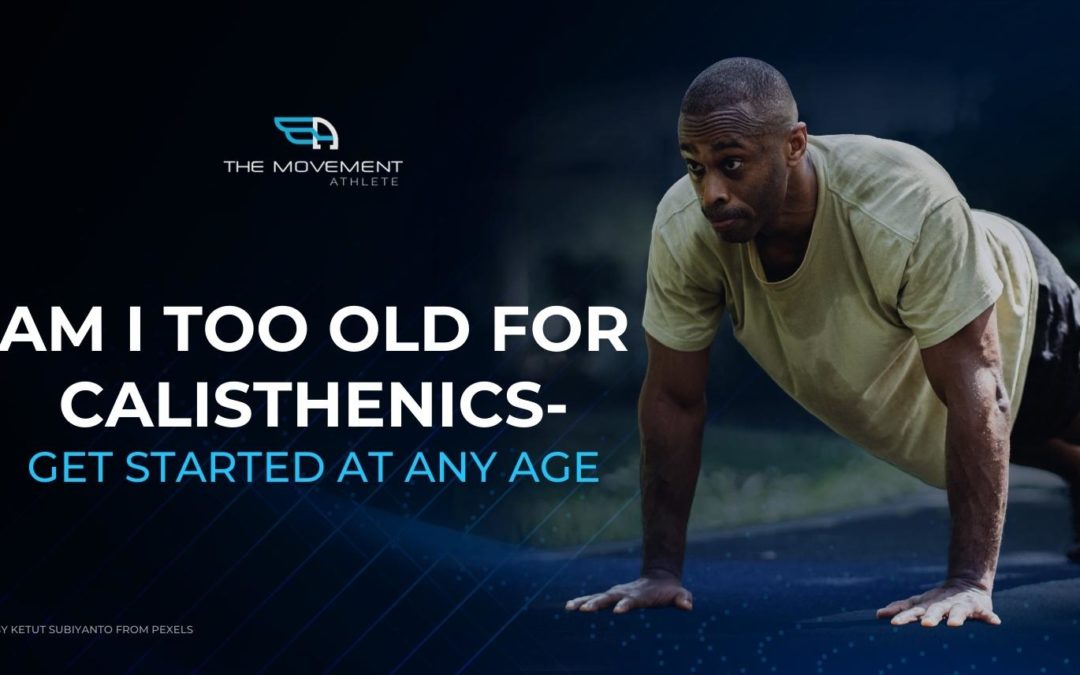
Join the tribe of Movement & Calisthenics Athletes – people just like you that are working with their own body weight to get strength, lose fat build muscle, recover from injuries and live their best lives!
It’s never too late to start a fitness routine, and calisthenics is a great way to get in shape no matter what your age. This article will discuss how you can get started with calisthenics at any age, no matter how “old” you think you are.
We’ll also give you some tips for staying motivated and keeping up with your routine. Anyone can benefit from calisthenics – regardless of their age. So whether you’re in your 30s, 40s, 50s, or beyond, don’t let age hold you back from getting fit and healthy!
False assumption
Many think that calisthenics is only for the youth. While it’s ideal to start young to be able to reap even more benefits, there’s nothing wrong with starting during your 30s or even in your 60s. The benefits are just as great, and it’s never too late to improve your health.
🔥 Take 68-year old grandmom, Carol, for example. She never stops to keep her health in tip-top shape. That’s why she still feels strong and mobile at her amazing age range. Read more of Carol’s story here:
📍 Find Out How Carol is 68 and Stronger than Ever!
Another one is Dave. He was a very busy dad who started calisthenics and is now making progress ever since he started. More of his story here:
📍 How This Busy Dad Got Fit and Strong with Calisthenics
Why you should train for strength and muscle
Since you’re “older”, you might think that you won’t need to train for strength or muscle. However, this couldn’t be further from the truth! As you age, you will lose muscle mass regardless of how active you are – it’s just a natural part of the aging process. This is why it’s so important to keep up with strength training, even as you get older. Not only will it help improve your physique and confidence, but it will also improve your overall health and reduce your risk of injuries.
📍 What Does It Mean to be Strong in the Real World?
🤔What you can expect for training at a later age
🎯A tad bit slower progress
At the age of 30, individuals lose muscle mass at a rate of about 0.55% per year, as opposed to the average individual who begins losing muscle mass at age 40. This is largely since older people have less testosterone and growth hormone production than their younger counterparts. So if you’re starting calisthenics in your 30s or beyond, be patient. Expect a slower progress rate, but know that you’re still making progress – it’s just slower than when you were younger.
🔥 52-year old school administrator Adam can even do exercises many of his students can’t. It’s all about allocating importance to fitness and health. Here’s Adam’s story: How to Get Stronger as You Age
🎯More cautious actions
While calisthenics is for everyone at every age and skill level, anyone who’s just starting out should consider their specific conditions and take things slow. As we all get older, it’s inevitable to come across some weaknesses and injuries. If you’re starting calisthenics at an older age, you likely have some preexisting conditions that you need to take into account when planning your routine. Don’t try to do too much right away – take things slow and steady, and progress as your body allows.
Don’t push yourself too hard – take it easy and let your body get used to the new routine. Listen to your body, and if you feel any pain or discomfort, stop what you’re doing and consult a physician.
📍 Here’s an article on How to Avoid Injury When Training with Calisthenics.
Why calisthenics works
✨Convenience
Calisthenics requires minimal equipment and can be done practically anywhere – making it a very convenient option for those who want to get fit but don’t have the time or resources to go to the gym.
✨Flexibility in goals
Calisthenics also offers a lot of flexibility in terms of how you train. You can do it at your own pace, and you can prepare for different goals, such as learning a new skill, developing endurance, improving mobility, building strength and muscle.
✨Scalability
Many people don’t see this, especially when doing push-ups and pull-ups, but exercises can be adjusted depending on your skill level to accommodate your current deficiencies.
A common reason people have bad exercise form, push-ups, for example, is that they are not yet prepared to do the exercise. As a result, push-ups with arching back, elevated shoulders, flaring elbows, disengaged abs are committed. This will sabotage your progress and can eventually lead to injury.
If this is the situation, SCALE BACK the exercise. Calisthenics is progressive. You can make progress by reducing the intensity of the push-up by using the proper progression that suits your skill level. Only then you will make meaningful and safe progress.
Every exercise in calisthenics has a progression. You just have to know more about each exercise to do so. Here’s a list of the calisthenics fundamentals and their corresponding progressions that you should know:
- ✅ Push-ups
- ✅ Pull-ups
- ✅ Dips
- ✅ Squats
- ✅ Ab wheel
- ✅ Ab exercises
More in-depth calisthenics PRO’s and CON’s here: Is calisthenics really a better way to train?
Don’t get us wrong. We don’t want to be biased in letting you know what approach you should take. This article challenges the reason why you should train calisthenics and just lets you know if ever when calisthenics is not for you.

Tips for getting started👊
Starting calisthenics at a later age can feel intimidating at the start. Luckily, you don’t need to go to the gym where other people can see you. You can do it in your own home until you get comfortable doing it with other people.
Below are some helpful tips you should know to get you going the right way.
⚡️Set realistic expectations
Time can add a minor inconvenience to our fitness journey. As we get older, our bodies will adapt to changes a little slower than when we were younger. However, this does not mean that it’s impossible to fit in our later years.
In addition, other complications should be considered. The once sturdy joints might not be as rigid as before. As a result, the mobile legs might not squat low to the ground.
This means when set for a goal, stay patient with your progress.
🔥 Martin, a 51 year old Movement Athlete, has thoughtfully said, “Put your ego aside. Take small steps, and continuity is key to every success.”
If you’ve always wanted to learn the straddle planche at the age of 40, don’t expect that you can get it within a few months (not maybe unless you’ve been doing it a lot in the past). Young athletes who have mastered the planche took years of training, so you will add a bit more time to your timeline as you get older.
Setting realistic expectations allows you to train with much fewer frustrations. This also means that you’re more likely to stick to your training instead of quitting early in your journey.
If you’re not making any gains at all, better take a step back and check other variables that might be holding you back because it might also not be your age. For more help, these are the 9 Mistakes Why You Are Not Making Progress with Calisthenics
If calisthenics is not for you, you can always move to a different training approach or combine weight training with calisthenics to spice things up.
⚡️Prepare your environment
Luckily, calisthenics is a convenient approach to fitness. Not much equipment is involved, but it’s best to set your space for your training. The more accessible it is, the easier you can to get started with your training.
Whether you train in your living room or in your garage, make sure there’s not a lot of set-ups needed. Calisthenics equipment is very easy to store. In fact, some, like pull-up bars, are already prepped if it’s drilled on a wall.
📍 If you’re looking into what calisthenics equipment you need for your home gym, here’s the article for you: The Ultimate Guide to Calisthenics Equipment and Cheap Ways to Replace It
Here’s also a rundown of the pieces you might want to invest in for your convenience and to open up the exercise options you can do at home. Don’t worry. These are very accessible and can accommodate any price range.
- ☑️ Dip station
- ☑️ Pull-up bar
- ☑️ Gymnastics rings
- ☑️ Set of resistance bands
- ☑️ Chalk
Setting your environment also prepares your mindset and takes away the hassle of prepping for the workout.
💪 If you need help on scheduling and fining time for your workout, here are 10 tips for Movement Athletes around the world to help you out: How to Finally Find Time to Work Out
⚡️Sweat is not an indicator of hard work
It feels great when you’re sweating! But you might also not sweat more than expected especially when working with strengthening exercises.
☝️ Don’t worry; this does not mean that you’re not working hard. Sweating is simply a response to the heat your body produces when it works harder than normal. Also, the strengthening exercises don’t raise the heart rate much compared to cardiovascular exercises.
In strength and muscle building training, you need to get ample rest in between each set to maximize your performance and gains. The rest periods will allow your body to recover for the succeeding strength set while lowering your heart rate.
For cardiovascular work, your heart rate will consistently be on a high because of the little to no rest required for the training format.
📍For more help on rest periods for different training styles, check out this article: How Long Should I Rest in between Sets?
⚡️Listen to your body
This is the most critical point. When you’re training, always listen to your body for any signs of discomfort.
The old adage, “No pain, no gain”, is used entirely out of context. Pain here is a metaphor for hard work and not literal pain.
Pushing through pain is not a good indicator that you’re working hard or making progress. Pain is an indicator that something is wrong. Injuries will set you back, so it’s best to avoid them by scaling down an exercise when needed and progressing correctly.
⚡️Cover nutrition and recovery
Sleep and proper sustenance are equally, if not more important, as the training itself. So no matter how hard you train or how smart your training program is, don’t expect to make any progress if you do not satisfy these two crucial factors.
Inadequate sleep will impair your cognitive function, increase stress levels, and decrease physical performance. In addition, research has supported that lack of sleep also negatively affects muscle recovery after exercise.
Meanwhile, inadequate nutrition can lead to deficiencies that will also impede your training progress. Nutrition feels like a complicated topic. While if you want to get into things, it can get complex, it doesn’t have to be that way in application. Here’s a 4 Minimalist Approach to Nutrition to Get You Started.
Both of these are essential for repairing and building muscle tissue. Muscles don’t grow while you’re working out; they grow when you’re resting.
⚡️Start according to your skill level
The number one killer of progress and motivation and bringer of injuries and frustrations is beginning your workout that doesn’t suit your level.
There are tons of calisthenics workout available, both free or even paid, that only provides a cookie-cutter workout. This means that the program is too general and can be adjusted, if not at all, at a very minimal level. Training with this approach leads to a greater risk of stagnation and injuries since the overall difficulty of the program structure can be too demanding on your body if you’re not prepared for it. It can also be worthless in making progress if it’s not challenging enough to stimulate your body.
Everybody is different. Even if you’re a beginner, you will probably have different strengths and weaknesses compared to other beginners. Skill level can’t easily be divided into three categories.


So let’s answer all your questions you might have about “Am I too old for calisthenics?”
What age is best for calisthenics?
There is no definitive answer to this question as it largely depends on the individual’s level of fitness and strength. However, as a general rule of thumb, calisthenics exercises can be performed by people of all ages.
Calisthenics is actually great for people who want to get stronger for life as it helps build functional strength. This type of strength is gained by using your bodyweight to perform exercises that work multiple muscle groups at the same time.
This is in contrast to weightlifting, which often focuses on isolating individual muscles and working them through a set range of motion.
Some of the best exercises for building functional strength include pull-ups, push-ups, squats, lunges, and dips. These exercises can all be performed using just your bodyweight and are therefore suitable for people of all ages and fitness levels.
If you are new to calisthenics, then it is always best to start slowly and gradually increase the intensity of your workouts as you get stronger and more comfortable with the exercises. Take an assessment so you get a personalised calisthenics training program.
Can I start calisthenics at 30?
Yes, you can start calisthenics at 30. In fact, starting calisthenics at 30 is a great idea, as it can help you to stay in shape and improve your overall level of fitness.
A lot of people in their 30 come to our training program as this is the time when for the first time they start experiencing joins aches and pains from lifting weights and are looking for a better way to train.
Timo, 34 – How this overweight dad took his life back with calisthenics
Andreas, 36 – Mastering your body as you age
Luke, 31 – Personal trainer tries calisthenics
Manuel, 34, – “Calisthenics changed my life“
Is 40 too old to start calisthenics?
This is a question that many people ask, especially those who are approaching or have already reached the age of 40. The simple answer is no, you are never too old to start calisthenics!
Calisthenics is a form of physical activity that can be enjoyed by people of all ages and fitness levels. There are many benefits to be gained from practicing calisthenics, including improved strength, flexibility, and cardiovascular health.
If you are looking for a workout that is suitable for people of all ages and fitness levels, then calisthenics is definitely worth considering. There are numerous exercises that can be performed using just your bodyweight, so it is a great option for those who want to avoid using weights or other equipment.
Calisthenics is also a great way to get in shape and improve your overall fitness. If you are looking for an effective workout that will help you lose weight, tone your muscles, and improve your cardiovascular health, then calisthenics is definitely worth considering.
So, if you are wondering whether or not calisthenics is suitable for people over the age of 40, the answer is a resounding yes! Calisthenics is a great form of physical activity that can be enjoyed by people of all ages and fitness levels. Whether you are looking to improve your strength, flexibility, or cardiovascular health, calisthenics is definitely worth considering.
Here are just a few examples of people in their 40s who started calisthenics. Read their stories under the links
Dave, 46, How this busy dad recovered from and injury and got strong with calisthenics
Philippe, 44, – How Philipe used calisthenics to get back to climbing
Enilson, 44 – Surfer tries calisthenics and this happens
Andrew, 41, How Andrew ditched the gym and become the fittest he has ever been
Is 50 too old to start calisthenics?
No, 50 are not too old to start calisthenics. Calisthenics exercises can be performed by people of all ages. In fact, starting calisthenics at 40 or 50 can help you to stay in shape and improve your overall level of fitness. It’s actually beneficial to do calisthenics in your 50 because you can avoid age-related muscle loss.
The key to training at any level is assessment that will adjust the training to your strength and mobility levels.
Here are a few examples of people in their 50s who started calisthenics.
Read their stories under the links to see how they got started:
BJ, 57 – Why BJ switched from weight-lifting to calisthenics
Gerhard, 57 -How Gerhard got insanely strong and mobile without a gym
Stijin, 54 – How calisthenics helped Stijn overcome chronic illness
Adam, 52 – How to get stronger as you age
What sport is best for longevity?
There is no scientific evidence to suggest that any one sport is best for longevity. However, the physical and mental health benefits of calisthenics can certainly improve your quality of life. Additionally, there are many different types of calisthenics exercises that can be tailored to people of all ages and fitness levels. So whether you’re 30 or 50, calisthenics can be a great way to stay in shape and improve your overall health.
Is calisthenics good for arthritis?
As far as arthritis goes, calisthenics may actually help to improve symptoms. This is because calisthenics can help to strengthen the muscles around the joints, which can help to stabilize the joint and reduce pain. Additionally, calisthenics can help to increase range of motion, which can also help to reduce pain and improve mobility. However, it’s important to consult with a doctor before starting any new exercise regime, especially if you have arthritis.
Do calisthenics live longer?
There is no scientific evidence to suggest that calisthenics can help you to live longer. However, the physical and mental health benefits of calisthenics can certainly improve your quality of life. Additionally, calisthenics exercises can be tailored to people of all ages and fitness levels, so they can be enjoyed by people of all ages.
Is calisthenics good for arthritis?
As far as arthritis goes, calisthenics may actually help to improve symptoms. This is because calisthenics can help to strengthen the muscles around the joints, which can help to stabilize the joint and reduce pain. Additionally, calisthenics can help to increase range of motion, which can also help to reduce pain and improve mobility. However, it’s important to consult with a doctor before starting any new exercise regime, especially if you have arthritis.
You can read more on treating arthritis and other injuries with calisthenics
also here is a story or Ross, 35 and How calisthenics helped him fight pain
The Key to Starting Calisthenics at any age?
We mentioned it already multiple times, but the key to starting calisthenics at any age is ASSESSMENT & PERSONALISATION.
Just think about it, with progressive bodyweight strength training you can start at any level, and all the benefits of calisthenics comes from it progressive nature.
If exercises is too hard: you run into promoting compensation, movement dysfunction, and possible injury risk.
If exercises is too easy, it’s not promoting adaptation/development hence you are not making progress
So the key is to start just at the right level, and as you progress just adjust your training slightly every time.
And this is exactly what The Movement Athlete App does.
You can start for free with our free assessment and check it out for yourself.
📌Take away:
You are never too old to start gaining muscle and improving your health through calisthenics! If you’re in your 30s, 40s, 50s, or beyond, your body always has still its potential to grow and change for the better.💯
As mentioned in our last tip, the best and safest way is to take a tailored approach to your training. If you’re interested in getting your personalized with your calisthenics fitness journey, check out the quick assessment below.
Don’t let age hold you back!💪
